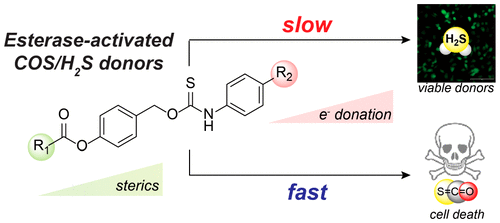当前位置:
X-MOL 学术
›
ACS Chem. Biol.
›
论文详情
Our official English website, www.x-mol.net, welcomes your feedback! (Note: you will need to create a separate account there.)
Esterase-Triggered Self-Immolative Thiocarbamates Provide Insights into COS Cytotoxicity.
ACS Chemical Biology ( IF 4 ) Pub Date : 2019-01-17 , DOI: 10.1021/acschembio.8b00981 Carolyn M Levinn 1 , Andrea K Steiger 1 , Michael D Pluth 1
ACS Chemical Biology ( IF 4 ) Pub Date : 2019-01-17 , DOI: 10.1021/acschembio.8b00981 Carolyn M Levinn 1 , Andrea K Steiger 1 , Michael D Pluth 1
Affiliation

|
Hydrogen sulfide (H2S) is an important gasotransmitter and biomolecule, and many synthetic small-molecule H2S donors have been developed for H2S-related research. One important class of triggerable H2S donors is self-immolative thiocarbamates, which function by releasing carbonyl sulfide (COS), which is rapidly converted to H2S by the ubiquitous enzyme carbonic anhydrase (CA). Prior studies of esterase-triggered thiocarbamate donors reported significant inhibition of mitochondrial bioenergetics and toxicity when compared to direct sulfide donors, suggesting that COS may function differently than H2S. Here, we report a suite of modular esterase-triggered self-immolative COS donors and include the synthesis, H2S release profiles, and cytotoxicity of the developed donors. We demonstrate that the rate of ester hydrolysis correlates directly with the observed cytotoxicity in cell culture, which further supports the hypothesis that COS functions as more than a simple H2S shuttle in certain biological systems.
中文翻译:

酯酶触发的自消灭硫代氨基甲酸酯提供了对COS细胞毒性的认识。
硫化氢(H2S)是重要的气体传输剂和生物分子,并且已经开发出许多合成的小分子H2S供体用于与H2S相关的研究。一类重要的可触发H2S供体是自燃性硫代氨基甲酸酯,其通过释放羰基硫(COS)来起作用,而后者被普遍存在的碳酸酐酶(CA)迅速转化为H2S。酯酶触发的硫代氨基甲酸酯供体的先前研究报告,与直接硫化物供体相比,线粒体生物能学和毒性得到了显着抑制,这表明COS的功能可能不同于H2S。在这里,我们报告了一套模块化的酯酶触发的自焚COS供体,包括合成,H2S释放曲线和已开发供体的细胞毒性。
更新日期:2019-01-14
中文翻译:

酯酶触发的自消灭硫代氨基甲酸酯提供了对COS细胞毒性的认识。
硫化氢(H2S)是重要的气体传输剂和生物分子,并且已经开发出许多合成的小分子H2S供体用于与H2S相关的研究。一类重要的可触发H2S供体是自燃性硫代氨基甲酸酯,其通过释放羰基硫(COS)来起作用,而后者被普遍存在的碳酸酐酶(CA)迅速转化为H2S。酯酶触发的硫代氨基甲酸酯供体的先前研究报告,与直接硫化物供体相比,线粒体生物能学和毒性得到了显着抑制,这表明COS的功能可能不同于H2S。在这里,我们报告了一套模块化的酯酶触发的自焚COS供体,包括合成,H2S释放曲线和已开发供体的细胞毒性。



























 京公网安备 11010802027423号
京公网安备 11010802027423号